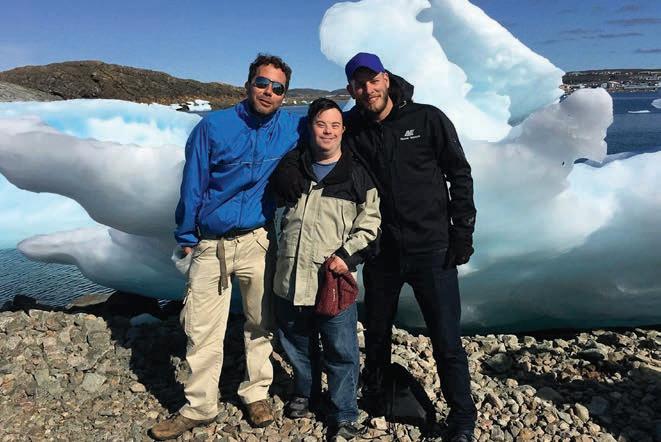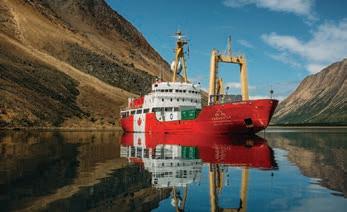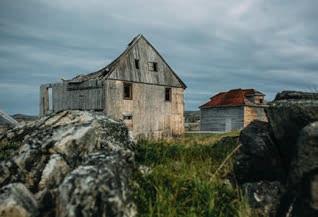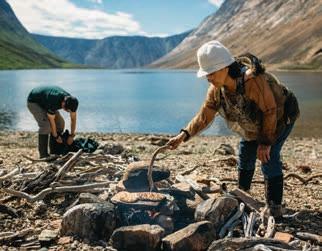
4 minute read
Canada 150: A Journey from Sea to Sea to Sea
Trevor Corkum with C3 participants Paul Sawka and John Thomas
In the Midst of the Journey CANADA C3 AS A METAPHOR FOR CANADA
TREVOR CORKUM ’94
There were so many moments in the week when we started to tear up. Unbidden, the raw emotion found us. By the end of my leg on the Canada C3 journey, nearly everyone onboard had taken a turn crying in front of folks who had been strangers just a few days earlier. That’s part of the magic of Canada C3.
One of those heart-opening moments happened for me while watching a TV interview between Peter Mansbridge and Dr. Nadine Caron, Canada’s first Indigenous surgeon. Surrounded by my shipmates, tucked into small couches and sitting at one another’s feet in front of the CBC footage, I was overcome by the grace, humility, and resolve with which Nadine responded to Peter’s gently probing questions about the legacy of Canada’s residential school system on her family and on Indigenous communities more generally.
It was all the more powerful because I was sitting beside Dr. Caron—by then, simply my friend Nadine—in the Downie Wenjack Legacy Room onboard the ship. We’d spent the last few days together, travelling through the spellbinding Torngat Mountains with a handful of Canadians of every conceivable background. And because we had already shared many moments of quiet reflection, passing Labradorian icebergs, or engaged in joyful conversation about books and hiking—the tears, when they came, were all the more powerful. The Canada C3 expedition is a unique sea journey traversing Canada’s three coastlines over 150 days. Conceived and managed by the Gatineau-based Students on Ice Foundation, C3’s hope is to engage Canadians in discussions around four key themes: reconciliation, diversity and inclusion, the environment, and youth engagement. The ship left Toronto on June 1. By the time it completes its 23,000-kilometre journey to Victoria in late October, it will have traversed Canada’s three coastlines, navigated the Northwest Passage, and served as a vehicle for asking important questions about who we are as a nation in 2017.


Jackie Dives
I served as writer-in-residence for leg six of the journey. As with all legs of the journey, a cross-section of about 25 Canadians took part in community events, cultural activities, and conversations around the journey’s themes. Among my group were a Conservative MP from rural Manitoba, celebrated comedian Shaun Majumder, a new Canadian originally from Rwanda, a Mi’kmaq medical student, and a Down Syndrome advocate named Paul, who happened to be my roommate and bandmate in our onboard trio, Paul Sawka and the C3s.
Our journey ran from Nain, Labrador—the capital of Nunatsiavut—to Iqualuit, Nunavut. Providing background and context on the Torngat Mountains National Park, and the cultural history of the Labrador Inuit, were Park Superintendent Gary Baikie and Inuit Elders Sophie Keelan and John Jararuse. From Sophie and John, we learned about the 1959 relocation of the Inuit from Hebron to communities further south, a decision that held devastating consequences for the community, as families were broken apart, and the Inuit were severed from their traditional hunting grounds.
While the C3 journey is centred around four key themes, it’s the question of reconciliation that has most passionately connected the hearts and minds of participants. Far-ranging, deeply personal, and complicated discussions continued far into the evening aboard the former Canadian Coast Guard icebreaker, exposing emotional wounds, subterranean guilt, and uncertainty about what reconciliation could or should look like.
The idea of the Legacy Room idea was conceived by Nova Scotia Assembly of First Nations (AFN) Regional Chief Morley Googoo. Chief Googoo partnered with the Gord Downie & Chanie Wenjack Fund to create this national call to action to organizations to create space for reconciliation. The Canada C3 Legacy Room contains resources and materials designed to encourage learning, and serves as a safe and sacred space to conduct ceremony, read, reflect, and engage in conversations like the ones we had during my time on the ship.
In many ways, Canada C3 journey is the perfect metaphor for where Canada finds itself in 2017. As the debate continues over whether it’s appropriate to “celebrate” Canada 150, most participants on my leg talked instead about the importance of using the moment to acknowledge and reflect on the shadow side of our country’s history, the many stories that remain still untold, absent from officially sanctioned historical narratives of record. What stories are missing? What stories still need to see the light of day? How should the tragic and traumatic memories recorded in the Truth and Reconciliation Commission Final Report serve as a permanent reminder for all Canadians about what happens when we lose touch with our humanity?
On our journey, we were fortunate to travel also with Natan Obed, the inspirational leader of Inuit Tapiriit Kanatami (ITK), Canada’s national Inuit organization. We met with vibrant Inuit youth taking up important leadership roles in their communities and across the country. We witnessed a palpable sense of hope and possibility, even amidst the stark reality of an epidemic of suicide among Inuit youth, a staggering ten times the national average.
Back in the Downie Wenjack Legacy Room, on the final night of our leg, we took turns reflecting on the emotions we’d moved through since the beginning of the journey. When we put aside the labels we wear in the day-to-day— writer, politician, comedian, activist—we found the space to meet one another heart to heart, honouring the indivisible wholeness in each other.
As we strive to bear witness to the stories that have shaped our individual lives—and those of our families, communities, our fledgling country—it’s from this place of deep truth and respect that we must move forward.











